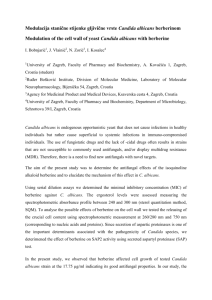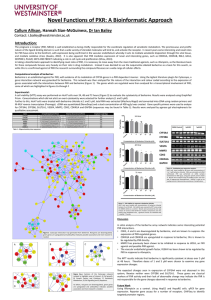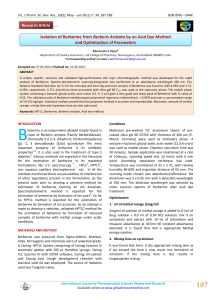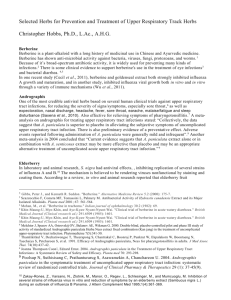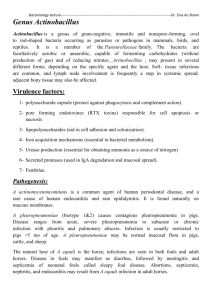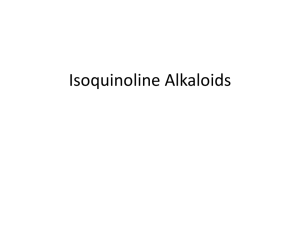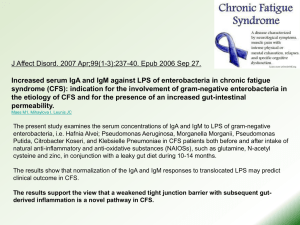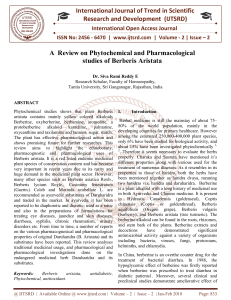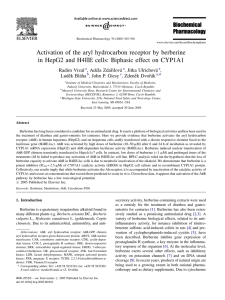SUPPLEMENTARY MATERIAL
advertisement
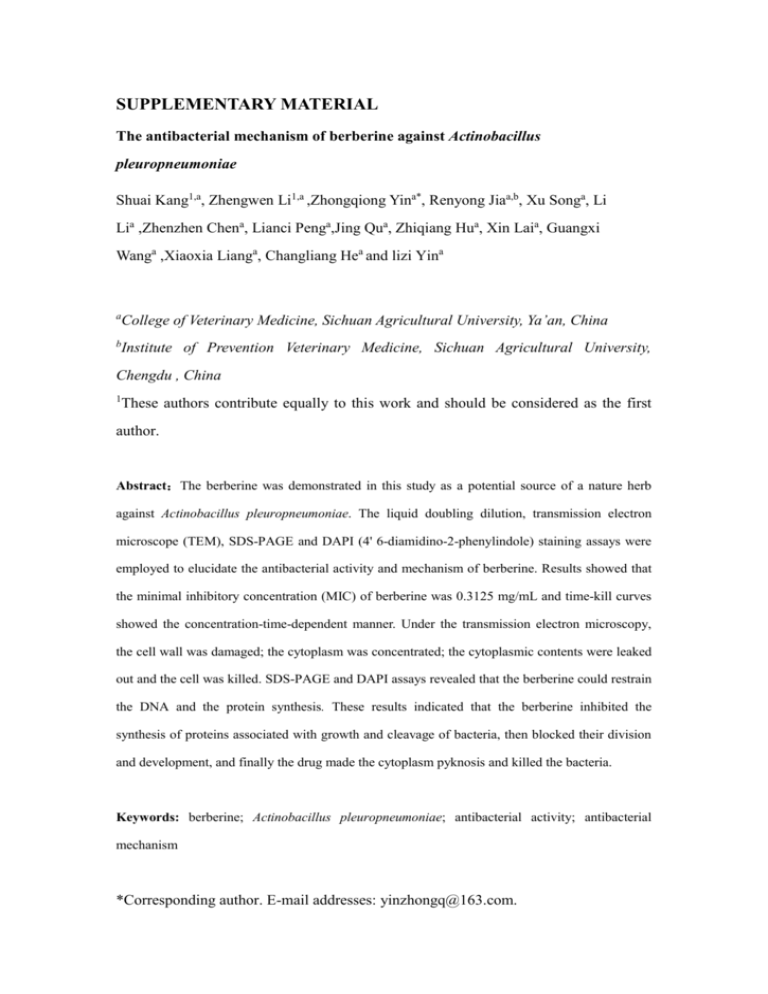
SUPPLEMENTARY MATERIAL The antibacterial mechanism of berberine against Actinobacillus pleuropneumoniae Shuai Kang1,a, Zhengwen Li1,a ,Zhongqiong Yina*, Renyong Jiaa,b, Xu Songa, Li Lia ,Zhenzhen Chena, Lianci Penga,Jing Qua, Zhiqiang Hua, Xin Laia, Guangxi Wanga ,Xiaoxia Lianga, Changliang Hea and lizi Yina a College of Veterinary Medicine, Sichuan Agricultural University, Ya’an, China b Institute of Prevention Veterinary Medicine, Sichuan Agricultural University, Chengdu , China 1 These authors contribute equally to this work and should be considered as the first author. Abstract:The berberine was demonstrated in this study as a potential source of a nature herb against Actinobacillus pleuropneumoniae. The liquid doubling dilution, transmission electron microscope (TEM), SDS-PAGE and DAPI (4' 6-diamidino-2-phenylindole) staining assays were employed to elucidate the antibacterial activity and mechanism of berberine. Results showed that the minimal inhibitory concentration (MIC) of berberine was 0.3125 mg/mL and time-kill curves showed the concentration-time-dependent manner. Under the transmission electron microscopy, the cell wall was damaged; the cytoplasm was concentrated; the cytoplasmic contents were leaked out and the cell was killed. SDS-PAGE and DAPI assays revealed that the berberine could restrain the DNA and the protein synthesis. These results indicated that the berberine inhibited the synthesis of proteins associated with growth and cleavage of bacteria, then blocked their division and development, and finally the drug made the cytoplasm pyknosis and killed the bacteria. Keywords: berberine; Actinobacillus pleuropneumoniae; antibacterial activity; antibacterial mechanism *Corresponding author. E-mail addresses: yinzhongq@163.com. Experimental Bacterial strain, chemicals and growing conditions A. pleuropneumoniae (ATCC 265 strain) was maintained on Trypticase Soy agar (TSA) contained 0.02% NAD. Inocula were incubated for 24h at 37℃ in Trypticase Soy broth(TSB) contained 0.02% NAD, and then diluted with TSB to achieve an inoculum of approximate 1×108CFU.mL-1. Bacterial strain and berberine were obtained from China Control Institute of Veterinary Bio-products and Pharmaceuticals, Beijing, China. Antibacterial susceptibility test Minimal inhibitory concentration (MIC) and minimal bactericidal concentration (MBC) values of berberine against A. pleuropneumoniae were determined by liquid doubling dilution described in the National Committee for Clinical Laboratory Standards (NCCLS,2008). The drug was dissolved in 3.13% DMSO at a final concentration ranging from 12.00mg/mL to 0.04 mg/mL, 3.13%DMSO was used as a negative control. The values of OD600 of each tube were measured by UV spectrophotometer before incubation and measured again after 24h of incubation at 37°C. When the tube showed the same values of OD600 after 24h, it indicated that there were no A.pleuropneumoniae colonies growing and that is the value of MIC (Hu et al., 2009). MBC was estimated as the least concentration of the samples where no visible growth on nutrient agar medium (Hu et al., 2009). All the experiments were performed in triplicate and the results were averaged. The study of time-kill curve The berberine was diluted with 3.13% DMSO to achieve 3 different concentrations are as follows: 0.5MIC, 1MIC and 2MIC. Berberine at three concentrations and control group were added with an initial inoculum of roughly 1×107CFU/mL to a final volume of 10mL. All samples were incubated at 37℃. After 0h, 2h, 4h, 8h, 12h, 24h and 36h, 0.1mL portion was removed from each dilution for colony counting. At least two replications were performed for each sample (Xu et al., 2008). Transmission electron microscopy 10mL of the A.pleuropneumoniae suspensions at the concentration of 1×107 CFU/mL were exposed to 1MIC concentration of berberine and then incubated at 37℃ for 2h, 4h and 8h. A 3.13% DMSO treated culture was used as the control. The A. pleuropneumoniae suspensions were centrifuged in sterile plastic centrifuge tubes at 8000g for 15min at 4℃ and were washed 3 times with PBS (Li et al., 2010). The supernatant was discarded and the samples was fixed in 2.5% glutaraldehyde, rinsed in buffer postfixed in 1% osmium tetroxide in 0.1M potassium phosphate for 2h at 4℃, dehydrated in ethanol and embedded in Epon-Araldite resin(Sangetha et al., 2009; Tao et al., 2011). Ultra thin sections were stained with uranyl acetate and lead citrate and observed under a TEM. DAPI staining assay The berberine was diluted into the concentration of 1MIC and added into the bacteria at the concentration of 1×107CFU/mL and cultured in oscillation incubator for 2h, 4h and 8h at 37℃. The untreated bacterial was set up as a control. Then 1mLberberine at 1MIC in different time and control group combined with DAPI (1ug/mL), respectively (Porteret al., 1980), and incubated at the room temperature for 1h. Stained bacteria were trapped on the microscope slide and observed and took photographs with fluorescence microscope (Nikon, Tokyo, Japan). SDS-PAGE protein analysis For SDA-PAGE, 4% stacking gel and 12% SDS-polyacrylamide gel were used, and gels were stained with Coomassie Blue(0.1% Coomassie Brilliant Blue R-250,20% methanol and 0.5% acetic acid) followed by distaining(40% methanol and 7% aceticacid) (Wang et al., 2010).For samples, the bacteria in the logarithmic phase was added into the liquid medium containing berberine at the concentration of 1MIC,and the final concentration of A.pleuropneumoniae was roughly of1×107CFU/mL. The control group was added with distilled water. Respectively, all samples cultured in oscillation incubator for 2h, 4h, 6h and 8h at 37℃ and diluted into the same OD480, and then centrifuged in sterile plastic centrifuge tubes. The protein samples and 4×SDS-PAGE loading buffer were mixed in a ratio of 3:1, then boiled for 5 min and centrifuged at 1000g for 15min; finally 15uL supernatant was taken for electrophoresis (Liu et al., 2012). References He,F., Yang,Y., Yang,G. and Yu,L.J.(2010) Studies on antibacterial activity and antibacterial mechanism of a novel polysaccharide from Streptomyces VirginiaH03. Food Control 21, 1257-1262. Liu,M.Y., Liu,F. and Zhou,T.(2012) Anti-Bacillus cereus mechanisms of Fructus Mume extract. Food science and technology 33, 130-134. Porter,K.G.(1980) The use of DAPI for identifying and counting aquatic microflora. Limnol Oceanogr 25, 943-948. Tao,G.F., Ding,J.K. and Sun,H.D.(2002) The Chemical Constituents of the Essential Oil from Leaves of Cinnamomum longepaniculatum in Hubei, China. J Wuhan Bot Res 20, 75-77. Wang,Z., Feng,S. and Huang,Y.(2010) Expression and characterization of a Granola frondosa hydrophobin in Pichia pastoris. Protein expression and purification 72, 19-25. Xu,J., Zhou,F., Ji,B.P., Pei,R.S. and Xu,N.(2008) The antibacterial mechanism of carvacrol and thymol against Escherichia coli. Letters in applied microbiology 47, 174-179. Figure S1. The chemical structure of berberine Figure S2. The Time-kill curve of berberine against A. pleuropneumoniae Figure S3. The control group: TEM graph (A) of A.pleuropneumoniae kept a normal morphology; The experimental group: TEM graph (B) of A.pleuropneumoniae exposed to MIC value of berberine for 2h, cytoplasmic material showed partly dissolved; For 4h, TEM graph (C) showed cell wall and cell membrane became thinner and cytoplasmic material showed clumping; For 8h, TEM graph (D)showed plasmolysis and bubble appeared. Figure S4. Control group: DNA fluorescence intensity of A.pleuropneumoniae showing fluorescing bright (A); the experimental group: DNA fluorescence intensity of treated group was wear off with the time extension and much fewer than the control group(B, C and D). Figure S5. SDS-PAGE profiles of treated and untreated group. Lane 5 is untreated cells of A.pleuropneumoniae. Lanes 1, 2, 3, 4 are treated cells with berberine at 1MIC for 2h, 4h, 6h and 8h, respectively.
